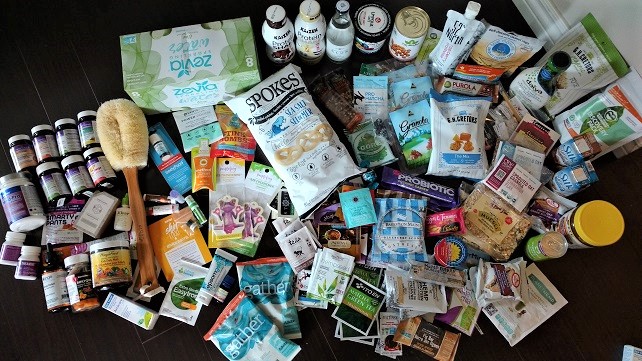Every year I attend the CHFA (Canadian Health Food Association) trade show that’s open only to retailers and health professionals. This past Sunday I spent the day wandering through the aisles with my mom (she’s a nurse practitioner), checking out what’s available in health supplements and healthy food options.
This is what I picked up.
Now, don’t get me wrong, I love the tried and true stuff. After all, I am practicing a medicine that has a history of thousands of years–Traditional Chinese Medicine’s foundations began 4000+ years ago. But, I also like to find out what’s new. Even TCM continues to evolve, with elements of our practice being fully modern. After all, don’t you prefer your acupuncture with sterile, fine, filiform needles that are thin as hair and glide with ease rather than a sharpened stone? Uh huh, I thought so. Plus, I love being able to offer biopuncture, press needles, silicone cups for cupping, microcurrent stimulation, Swarovski crystal ear seeds (a different post I’ll need to write about soon), and other newer aspects of TCM practice.
So, without further ado, here are some of the things I was most excited to see at this year’s CHFA trade show: foods with more medicinal benefits, companies giving back, healthy things that are also convenient, people passionate and knowledgeable about health!
Functional foods
Okay, so I’ve often been a bit perplexed about the idea of “functional foods.” After all, aren’t all whole foods functional, i.e. have health benefits? But the term functional foods refers to foods that “have a potentially positive effect on health beyond basic nutrition.” Still, the category is pretty broad. We’re finding out more and more that many foods contain phytonutrients, i.e. chemicals that the plants produce for their own benefit that also provide health perks for us.
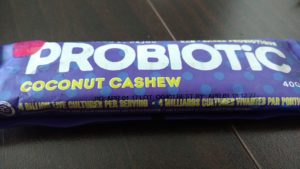 Another definition of functional foods is “processed foods containing ingredients that aid specific bodily functions in addition to being nutritious.” What I saw at the show were foods that have been added to. You get the food…plus you get a supplement of some sort. It’s not a new idea. Vitamin D has long been added to dairy products, you can buy omega-3 eggs, and iodine is added to table salt. What I saw though, were the addition of herbs and other nutrients, like this probiotic granola bar. This one is delicious (if you have a sweet tooth), soft, and chewy. It contains 4 billion active probiotic cultures. That’s a good amount! They also make drinks with their probiotics too, though I haven’t tried it yet. Plus, I see that they’ve partnered with the Creation of Hope initiative to help build water wells in Africa, with 5 cents donated for every bottle they sell.
Another definition of functional foods is “processed foods containing ingredients that aid specific bodily functions in addition to being nutritious.” What I saw at the show were foods that have been added to. You get the food…plus you get a supplement of some sort. It’s not a new idea. Vitamin D has long been added to dairy products, you can buy omega-3 eggs, and iodine is added to table salt. What I saw though, were the addition of herbs and other nutrients, like this probiotic granola bar. This one is delicious (if you have a sweet tooth), soft, and chewy. It contains 4 billion active probiotic cultures. That’s a good amount! They also make drinks with their probiotics too, though I haven’t tried it yet. Plus, I see that they’ve partnered with the Creation of Hope initiative to help build water wells in Africa, with 5 cents donated for every bottle they sell.
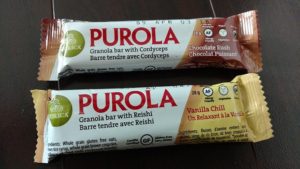 You may know, I’m a big fan of reishi mushrooms. It’s one of TCM’s top herbs! How can it not be, when its Chinese name “ling zhi” translates to “holy mushroom,” and when it’s also known as the “mushroom of immortality!” I write articles regularly for Mikei Red Reishi Mushroom, so I’ve done lots of research beyond the usual for this particular power herb. So, I was excited to see a snack bar with reishi in it (and one with cordyceps too–another powerful Chinese herb!). Though this brand’s reishi uses only the mycelia (root-like structure of a fungus), rather than the fruiting body (the stem and cap–the part you usually think about when you think “mushroom”)–unlike the Mikei brand–meaning it doesn’t contain all the beneficial compounds, it does still contain many polysaccharides that help with immune health. The powerful medicinal compounds in reishi and cordyceps taste awful. They are bitter. So, I was surprised to see them in a granola bar. But, here they were, and the bars taste good. They are crunchier, much firmer than the probiotic bars, and much less sweet. I’m not giving up my daily reishi supplement, but I’d have these snack bars as a topper up on occasion.
You may know, I’m a big fan of reishi mushrooms. It’s one of TCM’s top herbs! How can it not be, when its Chinese name “ling zhi” translates to “holy mushroom,” and when it’s also known as the “mushroom of immortality!” I write articles regularly for Mikei Red Reishi Mushroom, so I’ve done lots of research beyond the usual for this particular power herb. So, I was excited to see a snack bar with reishi in it (and one with cordyceps too–another powerful Chinese herb!). Though this brand’s reishi uses only the mycelia (root-like structure of a fungus), rather than the fruiting body (the stem and cap–the part you usually think about when you think “mushroom”)–unlike the Mikei brand–meaning it doesn’t contain all the beneficial compounds, it does still contain many polysaccharides that help with immune health. The powerful medicinal compounds in reishi and cordyceps taste awful. They are bitter. So, I was surprised to see them in a granola bar. But, here they were, and the bars taste good. They are crunchier, much firmer than the probiotic bars, and much less sweet. I’m not giving up my daily reishi supplement, but I’d have these snack bars as a topper up on occasion.
 Ok, this food isn’t about adding something medicinal to a food, but instead, it’s a functional food that is now being used when it was previously tossed away. Do you love coffee? Did you know that the coffee plant leaf has health benefits? Like many teas, it is rich in antioxidants. The cool thing about attending a trade health show is learning the stuff you didn’t know you didn’t know. Like, the coffee plant leaf contains mangiferin (found in mangoes, but not only mangoes), a compound that is anti a lot of things–antioxidant, antimicrobial (kills bad things you don’t want in your body), anti-diabetic, anti-inflammatory, anti-allergic–and analgesic (should I have called it “anti-pain”?). It also contains about as much caffeine as green tea and chlorogenic acids–the same compound that has made green coffee beans popular for weight loss. Bonus is jobs. The coffee industry is huge and many people are employed by it, but only for the 3-4 months per year when coffee beans can be harvested. What can they do during the remainder of the year? By harvesting the coffee leaf instead of tossing it, those people can still be employed. Plus, waste not, want not. This really a wise product: Wize Monkey Coffee Tea Leaf.
Ok, this food isn’t about adding something medicinal to a food, but instead, it’s a functional food that is now being used when it was previously tossed away. Do you love coffee? Did you know that the coffee plant leaf has health benefits? Like many teas, it is rich in antioxidants. The cool thing about attending a trade health show is learning the stuff you didn’t know you didn’t know. Like, the coffee plant leaf contains mangiferin (found in mangoes, but not only mangoes), a compound that is anti a lot of things–antioxidant, antimicrobial (kills bad things you don’t want in your body), anti-diabetic, anti-inflammatory, anti-allergic–and analgesic (should I have called it “anti-pain”?). It also contains about as much caffeine as green tea and chlorogenic acids–the same compound that has made green coffee beans popular for weight loss. Bonus is jobs. The coffee industry is huge and many people are employed by it, but only for the 3-4 months per year when coffee beans can be harvested. What can they do during the remainder of the year? By harvesting the coffee leaf instead of tossing it, those people can still be employed. Plus, waste not, want not. This really a wise product: Wize Monkey Coffee Tea Leaf.
Essential Oils
I’ve recently become minorly (my husband might say it’s not that minor) obsessed with essential oils. I blame two of my friends/colleagues (you know who you are!) who are even nuttier than I am about E.O. I’ve spent way too much money stocking up on oils, but the good thing is that I use them regularly, and I find them helpful! It’s a whole huge topic to go into all the health benefits of E.O., but it’s way beyond smelling nice. For one, did you know that your sense of smell is one of your most primitive and powerful senses? Your olfactory (smell) receptors are directly linked to your limbic system, the part of your brain that helps control your drive for survival, emotional stimuli, motivation, and some types of memory. You’ve likely experienced a powerful memory prompted by a smell–I love the smell of ice rinks because I spent a lot of time there as a figure skater, and Chinese herbal stores always make me feel instantly better.
 So, when I came across this company, Divine Essence, I was riveted with amount of information I learned about oils. Many of their oils are organic and they can offer the chemical breakdown analysis for proof of purity, if you ask. The thing about essential oils is that quality can vary. I bought one set of E.O. on a Groupon from a different company. Serves me right. It was cheap. Too cheap, and what I found was that the oils they sent are more like water. Good quality essential oils will have the Latin species name (there are many types of lavender, for instance, each with a different profile), where it was sourced, and that it’s 100% pure and natural. You know when you meet someone who is clearly passionate about what they do? These guys are that. Plus knowledgeable. This may be my favourite product I picked up at the CHFA show: organic helichrysum (also called everlasting or immortelle). It’s beautiful for skin health, an antiviral, antifungal, anti-inflammatory, etc. (note that most E.O. should be diluted in oil to use topically and should only be used internally with guided support from someone who’s qualified, despite what some marketing companies say).
So, when I came across this company, Divine Essence, I was riveted with amount of information I learned about oils. Many of their oils are organic and they can offer the chemical breakdown analysis for proof of purity, if you ask. The thing about essential oils is that quality can vary. I bought one set of E.O. on a Groupon from a different company. Serves me right. It was cheap. Too cheap, and what I found was that the oils they sent are more like water. Good quality essential oils will have the Latin species name (there are many types of lavender, for instance, each with a different profile), where it was sourced, and that it’s 100% pure and natural. You know when you meet someone who is clearly passionate about what they do? These guys are that. Plus knowledgeable. This may be my favourite product I picked up at the CHFA show: organic helichrysum (also called everlasting or immortelle). It’s beautiful for skin health, an antiviral, antifungal, anti-inflammatory, etc. (note that most E.O. should be diluted in oil to use topically and should only be used internally with guided support from someone who’s qualified, despite what some marketing companies say).
 If you’re not planning on going E.O. nuts, but you’d like your car or closet or gym bag to smell nice, here’s an option. I’m trying the peppermint one in my car. It’s strongly scented right now, so it’s a good thing I love peppermint. They apparently last for 3 weeks. Please, please, please don’t use the fake scents–those cardboard pine tree-shaped smelly things for your car, Febreeze, fake scented air fresheners, cologne, perfume. The chemicals in those products are harmful to us and to our environment. Raise your hand if you, like me, hold your breath when you walk through the perfume section of a department store or past the store Abercrombie & Fitch (stinks like a cologne war). I love these Purple Frog air fresheners because they combine one of my favourite animals (I collect frog knick knacks) with essential oils. 🙂
If you’re not planning on going E.O. nuts, but you’d like your car or closet or gym bag to smell nice, here’s an option. I’m trying the peppermint one in my car. It’s strongly scented right now, so it’s a good thing I love peppermint. They apparently last for 3 weeks. Please, please, please don’t use the fake scents–those cardboard pine tree-shaped smelly things for your car, Febreeze, fake scented air fresheners, cologne, perfume. The chemicals in those products are harmful to us and to our environment. Raise your hand if you, like me, hold your breath when you walk through the perfume section of a department store or past the store Abercrombie & Fitch (stinks like a cologne war). I love these Purple Frog air fresheners because they combine one of my favourite animals (I collect frog knick knacks) with essential oils. 🙂
Toiletries and Topicals
Toiletries. What an awful name for things that you use to make yourself look better. But, I didn’t create the word and it makes for nice alliteration in my subheading. 😉
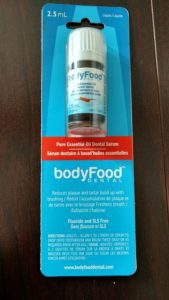 Brushing your teeth may not be exciting or ground breaking. But this oil (Body Food Dental) used as an alternative to toothpaste is quite different. It doesn’t foam. It doesn’t have chemicals. No SLS (sodium laureth/lauryl sulfate) or fluoride. You don’t need much. Just add 1-2 drops on your wet toothbrush and brush as you normally would. It’s a specially chosen blend of essential oils (you’ve already seen my love for E.O., as mentioned above) in coconut oil. It also tastes great. Not sure yet if I’ll convert over entirely, but I am alternating it with my natural toothpaste.
Brushing your teeth may not be exciting or ground breaking. But this oil (Body Food Dental) used as an alternative to toothpaste is quite different. It doesn’t foam. It doesn’t have chemicals. No SLS (sodium laureth/lauryl sulfate) or fluoride. You don’t need much. Just add 1-2 drops on your wet toothbrush and brush as you normally would. It’s a specially chosen blend of essential oils (you’ve already seen my love for E.O., as mentioned above) in coconut oil. It also tastes great. Not sure yet if I’ll convert over entirely, but I am alternating it with my natural toothpaste.
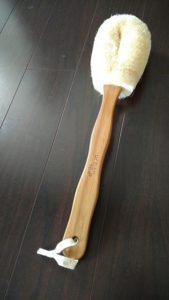 I often recommend dry brushing. Why? Because your lymphatic system will benefit, as will your skin. Why do I want to support my lymphatic system? Because the lymphatic system is part of your circulatory and immune systems, clearing away the garbage–dead cells, bacteria, viruses, cancer cells, toxins, excess fluid, and other waste products. I’ve written about lymphatic support here and here. This isn’t a new product at all, but it’s one I was happy to pick up–a dry brush. Practice dry brushing before you hop in the shower and you may find you catch fewer colds, have less puffiness, feel more energy, and have healthier skin. This brush by Urban Spa has a nice long handle, but I did notice that some of the bristles came off when brushing, so I might better recommend the Merben brand, as it comes with options for sensitive skin and is ethically sourced and made.
I often recommend dry brushing. Why? Because your lymphatic system will benefit, as will your skin. Why do I want to support my lymphatic system? Because the lymphatic system is part of your circulatory and immune systems, clearing away the garbage–dead cells, bacteria, viruses, cancer cells, toxins, excess fluid, and other waste products. I’ve written about lymphatic support here and here. This isn’t a new product at all, but it’s one I was happy to pick up–a dry brush. Practice dry brushing before you hop in the shower and you may find you catch fewer colds, have less puffiness, feel more energy, and have healthier skin. This brush by Urban Spa has a nice long handle, but I did notice that some of the bristles came off when brushing, so I might better recommend the Merben brand, as it comes with options for sensitive skin and is ethically sourced and made.
 This product counts as the one I’ve used the most since I picked up a sample. Some of you, as my patients, have already had this EpsomGel applied to your area of pain. I’ve tried topical magnesium products before. But they made me itchy, so I stopped using them. This one didn’t itch. Plus, it also contains arnica, which is good for treating injuries. It does have a light scent, but it’s not overwhelming. If you find that epsom salt baths help you relieve muscle tightness and cramping, then here’s your quick version that doesn’t require you to draw a bath (though you still might like to do that). I find it helpful for menstrual cramps or other muscle cramps, as well as tight muscles in general. If you want something topical for joint pain, and something that you can really feel as cooling and instantly pain relieving, then you might want to try SierraSil’s topical spray (I use that at the clinic). Either way, it’s great to have options for pain relief that won’t damage your liver, stomach, heart, or kidneys.
This product counts as the one I’ve used the most since I picked up a sample. Some of you, as my patients, have already had this EpsomGel applied to your area of pain. I’ve tried topical magnesium products before. But they made me itchy, so I stopped using them. This one didn’t itch. Plus, it also contains arnica, which is good for treating injuries. It does have a light scent, but it’s not overwhelming. If you find that epsom salt baths help you relieve muscle tightness and cramping, then here’s your quick version that doesn’t require you to draw a bath (though you still might like to do that). I find it helpful for menstrual cramps or other muscle cramps, as well as tight muscles in general. If you want something topical for joint pain, and something that you can really feel as cooling and instantly pain relieving, then you might want to try SierraSil’s topical spray (I use that at the clinic). Either way, it’s great to have options for pain relief that won’t damage your liver, stomach, heart, or kidneys.
I didn’t take a picture, but if there was one line of product I wish would disappear, it’s the bottled water category. I get it, sometimes you’re out and you want water. For sure, buy bottled if you’re in a country where the water will make you sick. Otherwise, drink tap or filtered tap water. I have a filter at home and plenty of re-usable, very nice looking and practical containers (some are collapsible and thus more portable for travel). At the trade show, I saw Mood Water. It was plastic bottles of a clear liquid and labels with pictures of emoticons. Cute, but “what’s in it?” I asked. “Water,” she said. Simply that. It was a marketing gimmick: Water is healthy; people like emoticons. But what an environmental waste. As much as I loved the show and am excited to see the innovations put forth next year, I’d like to no longer see stuff like that.
I’ve now recovered from my sampling of too many gluten-free, dairy-free, free trade, organic, vegan snacks, chocolate bars, cookies, ice cream, pastas, breads, spreads, etc. from last Sunday. But I’m still absorbing all the information that I gleaned from that day!

